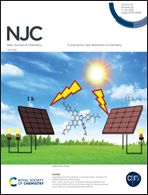Proton conduction in two hydrogen-bonded supramolecular lanthanide complexes†
Abstract
From the perspective of the proton conduction mechanism, there is a general notion that effective hydrogen bonding plays a key role in the high conductivity of crystalline proton conductive materials. In order to create more effective hydrogen bond networks resulting in high proton conduction, two hydrogen-bonded supramolecular lanthanide complexes based on imidazole dicarboxylate, {[Ln(m-FPhH2IDC)2(H2O)6]·(m-FPhH2IDC)·xH2O}n (x = 6, Ln = Eu (1); x = 13, Ln = Dy (2)) (m-FPhH3IDC = 2-(m-fluoro)phenyl-4,5-imidazole dicarboxylic acid), have been synthesized. AC impedance analysis shows that the optimized proton conductivity of 1 can reach up to 1.34 × 10−4 S cm−1 at 100 °C and 98% relative humidity (RH), which is 17 times higher than that of 2 (7.82 × 10−6 S cm−1). The proton conducting mechanisms have been investigated using structural analysis and Ea values. This comparative study of proton conduction between the two lanthanide complexes provides new insight for better understanding the design and development of new proton conductive metal–organic complexes with high proton conductivity.



 Please wait while we load your content...
Please wait while we load your content...